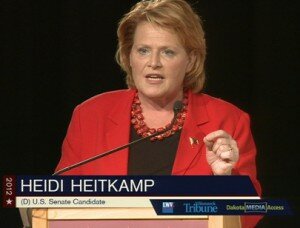(CLIMATE CHANGE DISPATCH) – North Dakota Democratic Sen. Heidi Heitkamp has a dire warning for the natural gas industry: you’re next on the Environmental Protection Agency’s hit list.
By Michael Bastasch, Daily Caller
“When that is done, and the stake is through the heart of coal, they will come for you next,”
Heitkamp told energy executives on Capitol Hill Thursday.
Last week, the EPA proposed regulations to cut carbon dioxide emissions from existing power plants 30 percent by 2030. The measure will force states to consider policies to reduce emissions from coal-fired power plants, which critics say will cripple the coal industry. Once coal plants have been regulated out of existence, Heitkamp warned, the EPA will focus its regulatory machine on natural gas — the country’s next largest source of electricity generation. Heitkamp, along with other energy state Democratic senators, have opposed the EPA’s power plant regulations, saying they would raise electricity prices and kill jobs.
In Heitkamp’s home state of North Dakota, 80 percent of electricity comes from coal. Environmental regulations on the coal industry have been driving a wedge in the Democratic party for years now, as coal mines and power plants are shut down across the country and thousands are being laid off — many of these shutdowns and layoffs are occurring in Democratic states.
“We’ve got huge regulatory pressure on coal combined with lower natural gas prices causing fuel switching,” Heitkamp added. “So we need a strategy that works for the American people.”
Kentucky and West Virginia, both led by Democratic governors, have opposed EPA rules that place more restrictions on coal power generation and mining. Both Gov. Earl Ray Tomblin of West Virginia and Gov. Steve Beshear of Kentucky have joined a coalition of federal and state lawmakers opposing the EPA’s new rule.
“Governor Tomblin believes the proposals unveiled this week fall far short of the balance that must exist if West Virginia is to continue to grow and prosper,” a Tomblin spokesman told The Daily Caller News Foundation. “That’s why he already joined with a bipartisan group of state and federal officials, business and labor leaders to express concern about the proposed rules, and why he will continue to gather information about the negative effects they would have on the state and communicate those findings with the EPA.”
“He plans to work with governors across the country who understand that the higher electric prices sure to follow if these rules are adopted would make economic growth difficult and put the United States at a disadvantage compared to the rest of the world,” Tomblin’s spokesman added.
The EPA says its new rule is necessary for tackling global warming and improving public health. The agency even claims that the rule would create jobs in the natural gas industry as prices rise and more gas is used for electricity generation.
EPA officials also said electricity prices will decline, not rise, like critics of the rule have charged.
“Climate change, fueled by carbon pollution, supercharges risks to our health, our economy, and our way of life,” said EPA administrator Gina McCarthy. “By leveraging cleaner energy sources and cutting energy waste, this plan will clean the air we breathe while helping slow climate change so we can leave a safe and healthy future for our kids.”
“We don’t have to choose between a healthy economy and a healthy environment–our action will sharpen America’s competitive edge, spur innovation, and create jobs,” McCarthy said.
But those electricity price decreases won’t come until 2030, according to the EPA’s economic analysis of the rule. Until the rule would raise electricity prices 6 or 7 percent. Once the price impacts of other pending EPA rules are included, electricity prices could increase by more than 10 percent by 2020. Furthermore, the rules impacts will have virtually no impact on global warming — the main reason the rule is being proposed.
The EPA’s rule would only decrease global carbon dioxide emissions less than one percent. This would only impact global temperature increases by 0.016 degrees Fahrenheit and stem rising sea levels by 1/100th of an inch, according to a report by the American Coalition for Clean Coal Electricity.
“EPA and White House officials began the sales pitch for their new carbon regulations earlier this week, with the expected dose of fiery rhetoric and misleading claims,” said Laura Sheehan, spokeswoman for ACCCE. “As speculation has turned to scrutiny, it has become clear that many of EPA’s most fundamental claims about the rule are more aptly classified as myths.”











